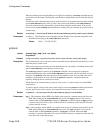Configuration Commands
Page 260 7750 SR OS Router Configuration Guide
An existing route prefix in the RTM must be active (used by the IP forwarding engine) to clear the
event operational state. It may be less specific (the defined prefix may be contained in a larger prefix
according to Classless Inter-Domain Routing (CIDR) techniques) if the event has the less-specific
statement defined. The less specific route that incorporates the router prefix may be the default route
(0.0.0.0) if the less-specific allow-default statement is defined. The matching prefix may be required
to have a specific next hop IP address if defined by the event next-hop command. Finally, the source
of the RTM prefix may be required to be one of the dynamic routing protocols or be statically defined
if defined by the event protocol command. If an RTM prefix is not found that matches all the above
criteria (if defined in the event control commands), the event is considered to be set. If a matching
prefix is found in the RTM, the event is considered to be cleared.
When an event transitions from clear to set, the set is processed immediately and must be reflected in
the associated virtual router instances in-use priority value. As the event transitions from clear to set,
a hold set timer is loaded with the value configured by the events hold-set command. This timer
prevents the event from clearing until it expires, damping the effect of event flapping. If the event
clears and becomes set again before the hold set timer expires, the timer is reset to the hold-set value,
extending the time before another clear can take effect.
The no form of the command is used to remove the specific prefix/mask-length monitoring event.
The event can be removed at anytime. When the event is removed, the in-use priority of all associated
virtual router instances must be reevaluated. The events hold-set timer has no effect on the removal
procedure.
Default no route-unknown — No route unknown priority control events are defined for the priority
control event policy.
Parameters prefix — The IP prefix address to be monitored by the route unknown priority control event in dotted
decimal notation.
Values 0.0.0.0 — 255.255.255.255
mask-length — The subnet mask length expressed as a decimal integer associated with the IP prefix
defining the route prefix to be monitored by the route unknown priority control event.
Values 0 — 32
Set – wrong next hop The route exists in the route table but does not meet the next-hop
requirements.
Set – wrong protocol The route exists in the route table but does not meet the protocol
requirements.
Set – less specific
found
The route exists in the route table but does is not an exact match and
does not meet any less-specific requirements.
Set – default best
match
The route exists in the route table as the default route but the default
route is not allowed for route matching.
Cleared – less specific
found
A less specific route exists in the route table and meets all criteria
including the less-specific requirements.
Cleared – found The route exists in the route table manager and meets all criteria.
route-unknown
Operational State
Description


















